Housing to 2040 - Present Voices, Future Lives: final report
A final report summarising and describing the responses gathered from children, young people and communities on Housing to 2040 as part of the travelling housing exhibition 'Present Voices, Future Lives' that toured twelve rural, urban and island locations across Scotland in 2019.
This document is part of a collection
3. Designing 'Present Voices Future Lives'
3.1 Curatorial narrative
'Present Voices Future Lives' was conceived as an exhibition combined with an immersive workshop, and a series of films to capture the voices of people in communities around Scotland talking about housing now and in the future. It was
curated and designed by Edinburgh University's School of Architecture and Landscape Architecture (ESALA), award-winning Scottish architects Collective Architecture and Peak15 Design, together with Gaia Research group.
The exhibition was designed in response to the Housing to 2040 draft vision and principles;[4] and invited conversations around the challenges we face now and going into the future surrounding how and where we live.
Exhibition themes around living and housing, offered the opportunity of discovery and discussion – gathering and sharing views about our housing needs and aspirations. Young people took part in workshops alongside the exhibition to explore the future, working to understand what our homes and communities should look and feel like in 2040.
The exhibition was accessible to people of all ages and was located in local schools and community buildings. Accompanying the exhibition were facilitated workshop sessions, designed to hear from a range of voices.
In each location a film was made to explore the particular character of the place and the challenges faced. These films made by Chris Leslie Productions provide insights principally through a conversation with a local resident or person with links to the community.
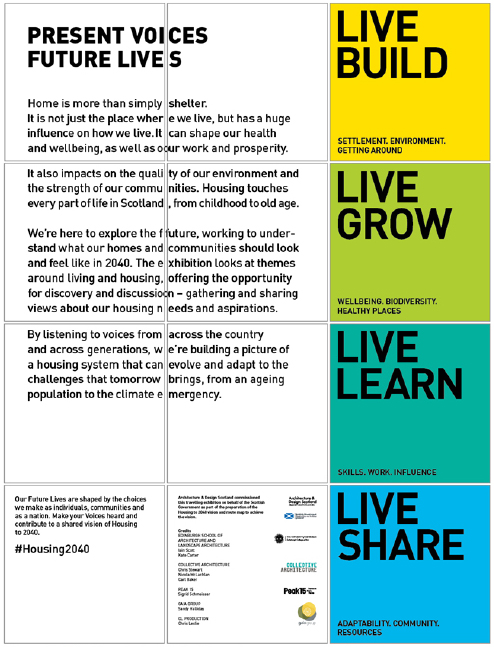
Figure description:
The ‘Present Voices, Future Lives’ Exhibition’s Introduction Panel provides a brief introduction and background of the exhibition and sets out the two main narrative elements of the exhibition. The first element of the exhibition presented the ‘Themes and Challenges’ we face as a society in Scotland in relation to how and where we live now and provision of homes for future generations. The second narrative presents ‘How We Live’ which presented an overview of forms of housing from across Scotland and new, emerging ways of living.
The exhibition has two main narrative elements. The first element of the exhibition presented the 'Themes and Challenges' we face as a society in Scotland in relation to how and where we live now and provision of homes for future generations. The second narrative presents 'How We Live' which presented an overview of forms of housing from across Scotland and new, emerging ways of living.
Themes and Challenges
The most significant challenges appear to be linked to an ageing population and the Climate Emergency, but the exhibition covered a broad range of issues for housing and communities. The challenges were based on careful and critical research of housing in Scotland and an extensive literature search of housing related issues from Scotland and internationally. They also referenced the Scottish Government's Housing to 2040 draft vision and principles and aimed to provide an expansive framework for the diverse range of issues facing housing. Overall, 12 distinct challenges developed from the analysis. These were arranged around four main themes to help visitors navigate the diverse range of issues facing housing.
The four themes are all about how we live: Live-Build; Live-Grow; Live-Learn; and Live-Share intentionally shifted the focus from housing in isolation to a broader appreciation of how we live and the connections with all facets of society. These themes provide a framework for the exhibition.
Live Build includes the challenges of Settlement, Environment and Getting Around. This incorporated how homes are built, where we build our settlements and why, how we 'get around' and the environmental impact of our buildings.
Live Grow includes the challenges of Well-Being, Healthy Places and Biodiversity. The links homes and communities to our health, well-being and places that contribute to healthy lives. It also considered biodiversity and the connection between nature and the built environment.
Live Learn includes the challenges of Skills, Work and Influence.
The skills and lifelong learning needed to create and upgrade housing in the future, and the places we work, how we work and the relationship this has with our home lives. Another important aspect to this theme was 'Influence' and how people can have a say in decisions about their homes and communities.
Live Share includes the challenges Adaptability, Community and Resources. The concept of sharing is at the heart of a fair society, and providing equality in access to material resources, energy, community and homes is important for a more sustainable future. Buildings will require to be more adaptable in the future, prolonging their lives in the interests of sustainability.
Organising the content in this way allowed visitors to navigate the diverse and complex range of issues relating to housing included in the exhibition. Each challenge included headline facts and information and a series of possible solutions or issues relating to the challenge.
Infographics were developed for each set of challenges. Use of these signposting devices complimented the text and images and guided visitors using this widely recognisable format. Each challenge is illustrated with images of precedents and case studies drawn from Scotland and Internationally.
How We Live
Figure 4: 'How we Live' themes
- High Rise & Micro Living
- Suburban & New Town
- Rural
- Tenements & Terraced
- Regeneration
- New Build Housing
- Custom Build
- Reuse Repurpose Recycling
- Supported Housing
- Travellers
- Co-Housing & Worker Housing
- Town Centre Living
The second element of the exhibition was information on 'How We Live' which included existing ways of living in Scotland and new, emerging forms of housing. These were not restricted to traditional 'housing typologies' but incorporated broader concepts of home and living, and consideration of collective place and community, for example 'Co-Housing' and 'Town Centre Living' illustrate collaborative and high density forms of housing. 'Custom Build' and 'Reuse, Repurpose, Recycling' demonstrate ways of creating homes through innovative construction and principles of circular economy. More temporary and itinerant ways of living such as gypsy travelling were included in the theme: 'Travellers'. This created a platform for considering existing and new housing in Scotland going forward to 2040.
Twelve different ways of living were presented to fit within the structure of the exhibition. Each approach to 'How We Live' was presented with an overview description and examples of housing, both from Scotland and Internationally (see Appendix 7.1). Images of case study projects provided illustrated examples presenting new and innovative housing within that category.
3.2 Design of the Exhibition
The exhibition was designed to be portable, flexible and adaptable so it could be placed in a range of school and community spaces. Ease of transport, mounting and demounting were some of the key considerations in the design process. Given the challenge of not knowing the size and character of each of the venues, the designers responded by providing a modular and adaptable installation of buildable elements that could be assembled within an assumed area of a standard community / gym hall. The buildable elements consisted of lightweight cubes, printed with content of the exhibition. The whole exhibition makes use of primarily renewable and recyclable material (cardboard and timber) to reduce the environmental impact of the exhibition.
The exhibition was designed to be assembled in 12 stacks of four cubes each which could then be placed by the exhibition team in different ways depending on the space and limitations of the different venues. The stacks were arranged according to the installation format in Figure 5 below.
The base layer which is not very accessible for presenting information was used for branding purposes. These cubes were printed with each of the twelve locations which the exhibition would visit and the exhibition logo.
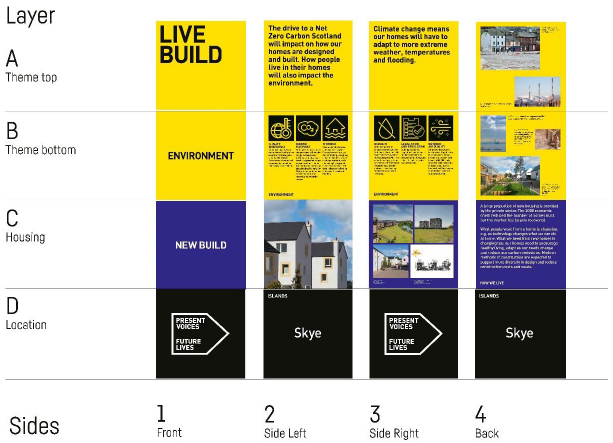
Figure description:
Image describing the construction of exhibition stacks used as part of the travelling housing exhibition. Stacks have four information elements. From bottom, branding, how we live, themes, and key challenges.
The second layer of cubes presented 'How We Live'. The top two layers of cubes were dedicated to present the main 'Themes' and the key challenges, each providing a range of issues and solutions associated with the particular challenge.
Each cube measured 500x500x500mm, with each stack two metres in height. Larger font was used on the upper layer and medium fonts used for the middle two layers, providing accessible reading material at different levels.
Colour was used in a powerful way to identify the main 'Themes' and 'How We Live'. This colour framework helped to guide visitors through the range of challenges and ways of living presented.
Live Build - Yellow
Live Grow - Green
Live Learn - Turquoise
Live Share - Blue
How We - Live Purple
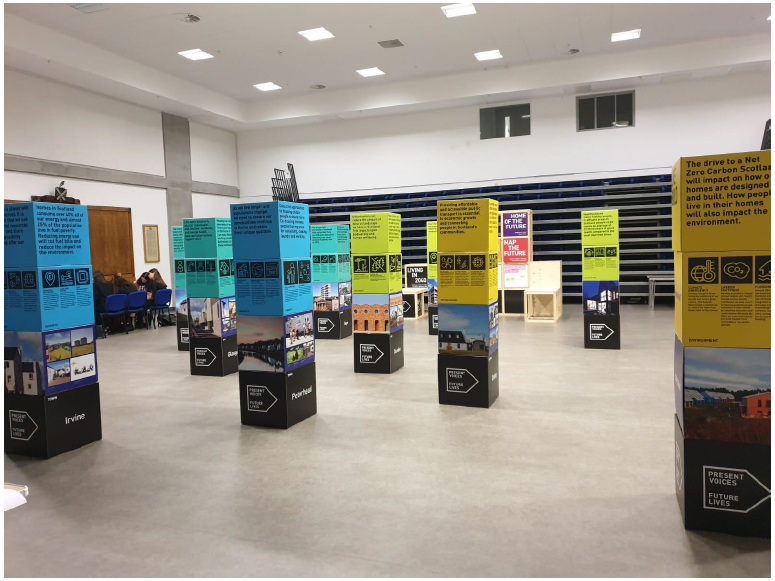
Figure description:
This picture presents the ‘Present Voices, Future Lives’ Exhibition installation in Inverness. A number of colourful exhibition stacks can be seen on the picture.
A timber framework was used as a focal point in the exhibition. It was used to present and foreground location specific information that was co-produced through workshop sessions. This included the priority themes for each community, and a map providing the base of a community model created during the workshop activities with young people. This engaged people in the themes of the exhibition from a local perspective.
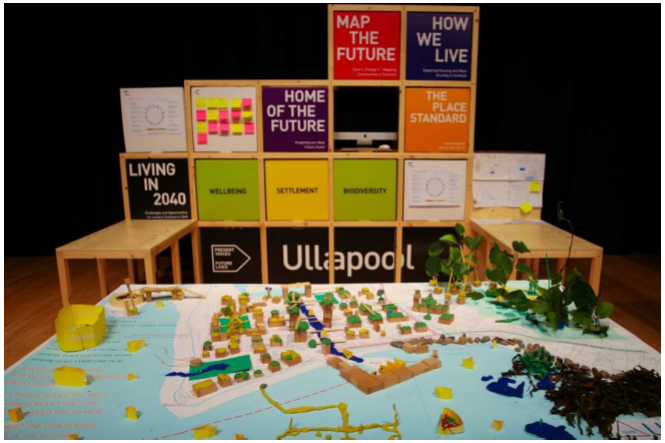
Figure description:
A timber framework was used as a focal point in the exhibition. It was used to present and foreground location specific information that was co-produced through workshop sessions. This included the priority themes for each community, and a 3D map providing the base of a community model created during the workshop activities with young people. Figure 7 captures an example of an installation of timber framework and Community Map in Ullapool, reflecting workshop outcomes.
3.3 Facilitated Workshops and Public Exhibition
Young people are the future generation that will be living in, renting, and buying housing in 2040. It is therefore important to engage young people in the conversation around future housing. The exhibition was principally taken to schools to engage with young people and provide the opportunity to talk about housing, and how we might live in the future. The workshops enabled data to be collected on people's everyday lives, homes and communities and gather feedback on lived experience and the priorities people have for 2040.
The exhibition was used in each location as a background to the workshop activities with groups of young people. This gave young people the opportunity to talk about how they live now, what they think are the most important challenges, and how they might live in the future. The findings from these workshops are presented in section 5.
The workshops were designed to be flexible and able to fit within the school timetable. The numbers of young people engaged in the workshops changed in each venue, and the team were able to adapt the format of the workshops accordingly. It was important to be able to adjust the pace for the age group and keep interest and engagement in the activities. Even the youngest children could still understand and participate in all of the workshops.
The workshop programme was the same in each location and the process is illustrated in this drawing by Chris Stewart of Collective Architecture, presented during the design phase of the exhibition.
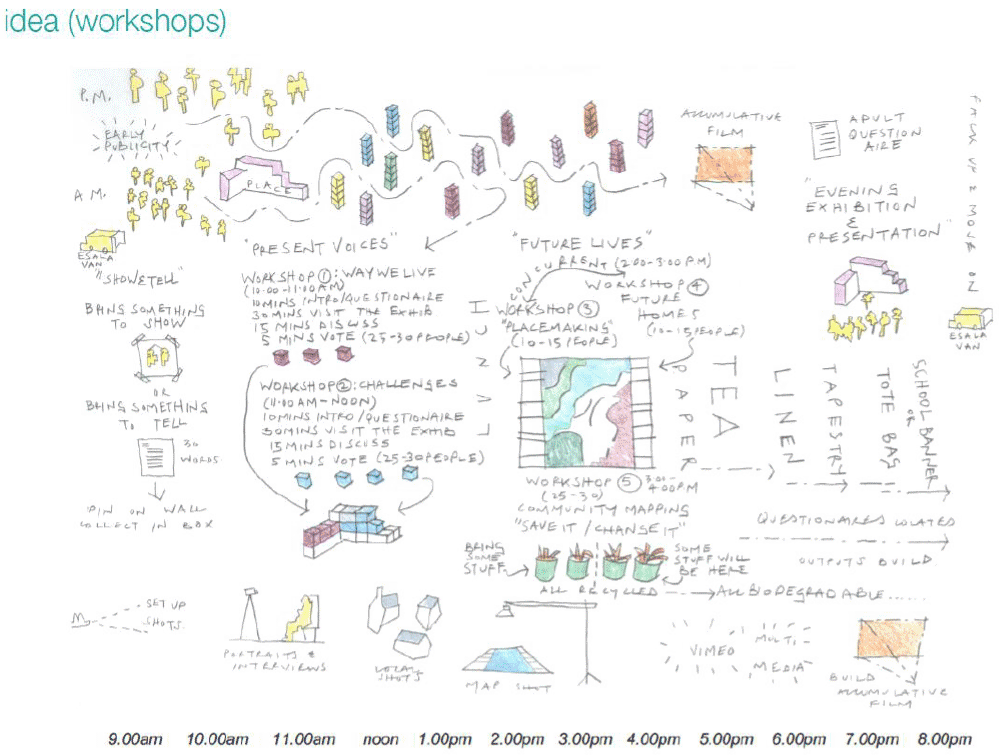
Figure description:
The workshop programme was the same in each of the 12 locations visited by the exhibition and the process is illustrated in a drawing of Workshop Activities in Figure 8 by Chris Stewart of Collective Architecture. This drawing was presented and supported the the design phase of the exhibition.
Workshop 1 – How We Live
This workshop was designed to allow people to tell us about the:
- Type of home they lived in
- Things they liked about their home
- Concerns they had in relation to their home and neighbourhood
- Other ways they would like to live
- Most typical ways of living in their local area
- Changes they anticipated to their area by 2040
Workshop 2 – Challenges to 2040
The second workshop was designed to allow people to rate the twelve challenges in the exhibition in relation to housing and communities, going forward to 2040.
Workshops 3 & 4 – The Home of the Future and the Place Standard
These two workshops generally ran in parallel.
The Home of the Future exercise was an invitation to participants to draw, diagram or write about their ideal home of the future.
The Place Standard Assessment tool - an A3 sheet (adapted by Collective Architecture) incorporating a scoring chart and questions about the place where you live.
Workshop 5 – Community Mapping
The community mapping exercise was the final workshop carried out in each location. The idea of this workshop was that it allowed participants to map out some of the issues uncovered in the previous workshops and to propose solutions to some of these issues in their local area. Participants were encouraged to be creative and model ideas starting from a map of their location.
Public Exhibition
In each location the exhibition was open to the public. These open public sessions following engagement with the school groups provided community members with the opportunity to view the exhibition and see the output of the workshops. As well as viewing the exhibition, evening visitors were invited to fill out questionnaires for Workshops 1 & 2 and complete a Place Standard Assessment. This produced further data on particular challenges facing local communities.
A set of cubes based on the Housing to 2040 draft vision and principles were located at the entrance to the venue, alongside Scottish Government leaflets which provided further information on Housing to 2040.
3.4 'Present Voices Future Lives' Films
A film was made in each location with the aim of capturing the character of the place and the lived experience of local people. The films are central to concept of 'Present Voices Future Lives' and provide a narrative of what people have to say about where they live and how they want it to be in the future. The films aimed to capture both the local landscape and context for housing, but also to draw out particular themes relevant to the location.
The series of films were created based on interviews with community members in each location visited. They incorporated footage of the natural and built environment. These are an important aspect of the narrative from the exhibition and capture local 'voices' and lived experiences from people within the community.
The interviews and films were produced by filmmaker Chris Leslie. The people taking part in the interviews were selected to present a diverse range of perspectives and reflect the issues and challenges relevant to the place.
Contact
Email: Housing2040@gov.scot
There is a problem
Thanks for your feedback